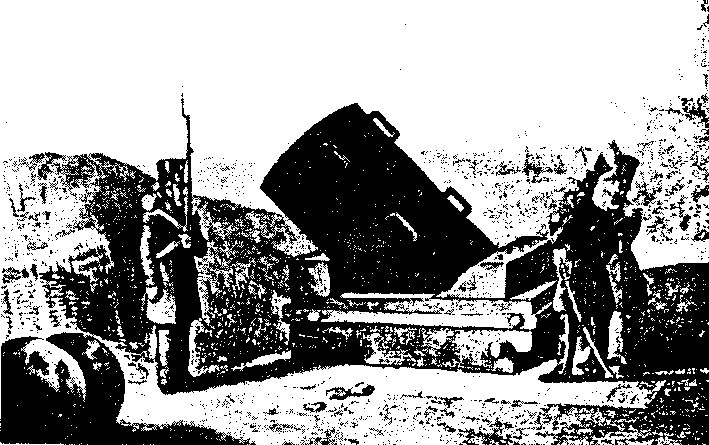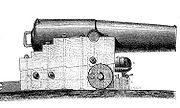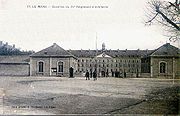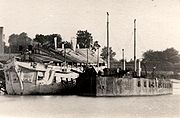
Henri-Joseph Paixhans
Encyclopedia

Henri-Joseph Paixhans graduated from the École Polytechnique
École Polytechnique
The École Polytechnique is a state-run institution of higher education and research in Palaiseau, Essonne, France, near Paris. Polytechnique is renowned for its four year undergraduate/graduate Master's program...
. He fought in the Napoleonic wars
Napoleonic Wars
The Napoleonic Wars were a series of wars declared against Napoleon's French Empire by opposing coalitions that ran from 1803 to 1815. As a continuation of the wars sparked by the French Revolution of 1789, they revolutionised European armies and played out on an unprecedented scale, mainly due to...
, was the representative (Député
Chamber of Deputies of France
Chamber of Deputies was the name given to several parliamentary bodies in France in the nineteenth and twentieth centuries:* 1814–1848 during the Bourbon Restoration and the July Monarchy, the Chamber of Deputies was the Lower chamber of the French Parliament, elected by census suffrage.*...
) for the Moselle
Moselle
Moselle is a department in the east of France named after the river Moselle.- History :Moselle is one of the original 83 departments created during the French Revolution on March 4, 1790...
department between 1830 and 1848, and became "General de Division" in 1848.
In 1823, he invented the first shell guns
Shell (projectile)
A shell is a payload-carrying projectile, which, as opposed to shot, contains an explosive or other filling, though modern usage sometimes includes large solid projectiles properly termed shot . Solid shot may contain a pyrotechnic compound if a tracer or spotting charge is used...
, which came to be called Paixhans guns (or "canon-obusiers" in the French Navy). Paixhans guns became the first naval guns to combine explosive shells
Shell (projectile)
A shell is a payload-carrying projectile, which, as opposed to shot, contains an explosive or other filling, though modern usage sometimes includes large solid projectiles properly termed shot . Solid shot may contain a pyrotechnic compound if a tracer or spotting charge is used...
and a flat trajectory, thereby triggering the demise of wooden ships, and the iron hull revolution in shipbuilding
Shipbuilding
Shipbuilding is the construction of ships and floating vessels. It normally takes place in a specialized facility known as a shipyard. Shipbuilders, also called shipwrights, follow a specialized occupation that traces its roots to before recorded history.Shipbuilding and ship repairs, both...
. Paixhans also invented a "Mortier monstre" ("Monster Mortar
Mortar (weapon)
A mortar is an indirect fire weapon that fires explosive projectiles known as bombs at low velocities, short ranges, and high-arcing ballistic trajectories. It is typically muzzle-loading and has a barrel length less than 15 times its caliber....
"), using 500 kg bombs, which was used to terrible effect in the Siege of Antwerp
Siege of Antwerp (1832)
The siege of the citadel of Antwerp took place after fighting in the Belgian Revolution ended. It occurred from 15 November to 23 December 1832 and faced off Dutch troops occupying Antwerp's citadel against France's Armée du Nord...
in 1832. He was also a naval theorist claiming that a few aggressively armed small units could destroy the largest naval units of the time, making him a precursor of the French "Jeune École
Jeune Ecole
The Jeune École was a strategic naval concept developed during the 19th century. It advocated the use of small, powerfully equipped units to combat a larger battleship fleet, and commerce raiders capable of ending the trade of the rival nation...
" school of thought.
The poet Victor Hugo
Victor Hugo
Victor-Marie Hugo was a Frenchpoet, playwright, novelist, essayist, visual artist, statesman, human rights activist and exponent of the Romantic movement in France....
wrote:
- "Terre! l'obus est Dieu, Paixhans est son prophète."
- ("Earth! the shell is God, Paixhans is his Prophet.")
Paixhans naval guns

French ship Pacificateur (1811)
The Pacificateur was an 80-gun Bucentaure-class 80-gun ship of the line of the French Navy, designed by Sané. She is notable for being the first ship to sustain damage from Paixhans shells....
in 1824.
The first Paixhans guns were founded in 1841. The barrel of the guns weighed about 10,000 pounds, and proved accurate to about two miles. In the 1840s, France, England, Russia and the United States had adopted the new naval guns.
The effect of the guns in an operational context was first demonstrated during the actions at Eckernförde in 1849 during the First Schleswig war
First War of Schleswig
The First Schleswig War or Three Years' War was the first round of military conflict in southern Denmark and northern Germany rooted in the Schleswig-Holstein Question, contesting the issue of who should control the Duchies of Schleswig and Holstein. The war, which lasted from 1848–1851,...
, and especially at the Battle of Sinop
Battle of Sinop
The Battle of Sinop, or the Battle of Sinope, took place on 30 November 1853 at Sinop, a sea port in northern Anatolia, when Imperial Russian warships struck and annihilated a patrol force of Ottoman ships anchored in the harbor...
in 1853 during the Crimean War
Crimean War
The Crimean War was a conflict fought between the Russian Empire and an alliance of the French Empire, the British Empire, the Ottoman Empire, and the Kingdom of Sardinia. The war was part of a long-running contest between the major European powers for influence over territories of the declining...
.
Ironclad warships
Wooden boats became so vulnerable that the only possible response could come with the introduction of the iron-hulled warshipWarship
A warship is a ship that is built and primarily intended for combat. Warships are usually built in a completely different way from merchant ships. As well as being armed, warships are designed to withstand damage and are usually faster and more maneuvrable than merchant ships...
. The first of them was the French La Gloire, which was a wooden ship with iron sheathing. She was soon followed by HMS Warrior
HMS Warrior (1860)
HMS Warrior was the first iron-hulled, armour-plated warship, built for the Royal Navy in response to the first ironclad warship, the French Gloire, launched a year earlier....
, which was iron-hulled with wooden backing.
Further developments

John A. Dahlgren
John Adolphus Bernard Dahlgren was a United States Navy leader. He headed the Union Navy's ordnance department during the American Civil War and designed several different kinds of guns and cannons that were considered part of the reason the Union won the war...
, who wrote:
Floating batteries

Dupuy de Lome
Dupuy de Lome may refer to:* Enrique Dupuy de Lôme, Spanish Minister to the United States in 1892* Henri Dupuy de Lôme, a French naval architect in the 19th century...
. Four of these ships were launched between 1861 and 1862. Originally designed for use in Cochinchina
Cochinchina
Cochinchina is a region encompassing the southern third of Vietnam whose principal city is Saigon. It was a French colony from 1862 to 1954. The later state of South Vietnam was created in 1954 by combining Cochinchina with southern Annam. In Vietnamese, the region is called Nam Bộ...
, they were built in wood and equipped with 4 ft batteries.
Writings
Paixhans wrote, among others:- "Considérations sur l'état actuel de l'artillerie des places" (1815)
- "Nouvelle force maritime" (1822), in which he envisionned a fleet protected by armour and equipped with explosive shells.
- "Force et faiblesse militaires de la France" (1830)
- "Constitution militaire de la France" (Paris 1849)

